CAMP SEAT
A very comfortable fireside camp seat can be made by driving two short stakes into the ground, so that the forks are pointing outwards, that is, away from the opposite stake. The bottom of the forks should be from 8 to 10 inches above the ground level.
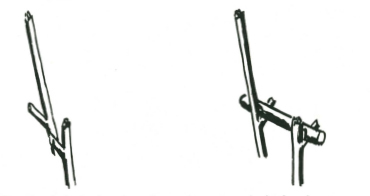
Two back forked stakes about three feet six inches long are driven into the ground, 15 to 18 inches behind these two short stakes. These back stakes should be driven in on a slight angle, leaning away from the two forward forks. The forks of the rear stakes should point outwards.
Both short and long stakes should be not less than two inches thick and the fork at least one and a half inches thick.
The short stakes should be at a convenient distance from the fireplace, anything from three feet to six feet, depending upon the size fire you usually build.
Cut two cross-bars, each about 3 inches thick, and cut nicks in these so they fit snugly in place in the forks, and connect front and rear forks.
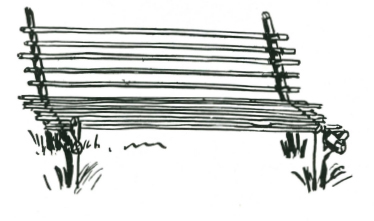
Lengthways, lay straight smooth sticks, one to two inches thick. These must be close together. Along the back, that is to the tall stakes, lash similar sticks from 2 to 3 inches apart.
This makes an excellent fireside camp seat, and the comfort it gives you will well repay the half-hour it took to build.
CAMP BEDS
A sound night’s rest is worth ten minutes’ toil. Time spent in making a camp bed that will keep you both comfortable and warm is time well spent.
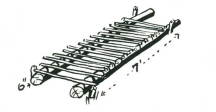
Cut two poles six or seven inches thick, and about seven feet long. Lay these parallel to each other, three feet apart; and to prevent them rolling, put pegs at head and foot, driven well into the ground with about a foot of the peg above the pole. Cut about twenty or thirty straight, strong sticks, three and a half feet long, and lay these every four inches across the two poles. Now on top of these cross sticks place two poles, three to four inches thick and seven feet long. They should lie against the pegs driven in to hold the two “bed” poles secure.
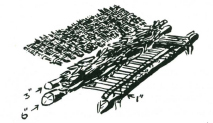
At the head end of the bed, lay about half a dozen cross sticks on top of these last two poles. Now cut green brushwood, fern, or waste green stuff, such as sucker growth, or weedy bush material, and put this so that the main stalks are lengthways along the bed. Pile it high between the two top poles, and lying across the cross sticks. The resulting bed will be as springy and comfortable as any you have ever slept on in your life.
If you are going to be in camp for a long period, you had better make yourself a camp mattress from grass on the camp loom, and if bedding is short you can weave a covering from dried grass on the same loom, and sleep as warm and snug as if you were between the blankets in your own bed at home.
CAMP BED OFF THE GROUND

A framework, similar to the table, with the table top only, is made, and the two poles are overlaid with sticks exactly as for the bed on the ground. When making a bed off the ground it is not necessary to have the forks as high as for the table. A camp bed should always be built off the ground in bad snake country, or in areas where ground pests such as leeches, ants, scrub-mites, chiggers or ticks are liable to be troublesome.
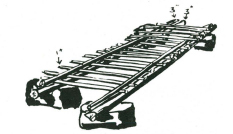
An alternative to the forked stakes and ground poles is the use of two piles of stones to support the sidepoles.
CAMP BED USING A COUPLE OF BAGS
A very comfortable camp bed can be made by setting up the two forked stakes as for the preceding camp bed, and two side poles are placed into the crotches of these so they are about 45 degrees slope. Two long, straight poles are cut, and passed through the two sides of two bags (holes are cut in the bottoms of each of the bags to allow the poles to pass through). The closed ends of the bags are towards the ends of the poles, and the bags overlap a few inches in the middle. The two bed poles with the bags are laid one on either side of the angle poles. The weight of the body, lying on the bags, keeps the side poles pulled well down on the angle poles. If the weather is cold, or greater comfort is required, a stuffing of dried grass or bracken fern inside the bags will serve to give greater softness, and also make this type of bed warmer.
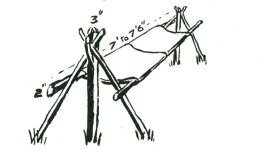
STICK HAMMOCK
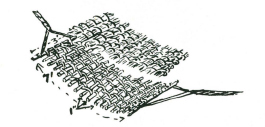
A camp loom is set up (see Camp Loom, page 97), and the hammock is woven, using vines, twisted bark fibres, grass rope or any suitable material for the weaving, and sticks about one inch thick for the cross parts. The hammock should be at least three feet wide by six feet six inches long. The end two spreaders should be two inches thick, and from these short lengths of rope are brought to the the hammock. A grass mattress, also woven on the camp loom, makes an excellent cover for the hammock.
CAMP LOOM
Two stout forked stakes, about two inches thick, are cut and driven into the ground with their lower prongs three feet above the ground, and facing away from the direction you wish to work. The distance between the stakes should be at least six inches wider than the widest article you want to weave. Across the forks a cross bar, about one inch thick, is laid. It is advisable to trim this cross bar of twigs and roughnesses. It should be fairly strong.
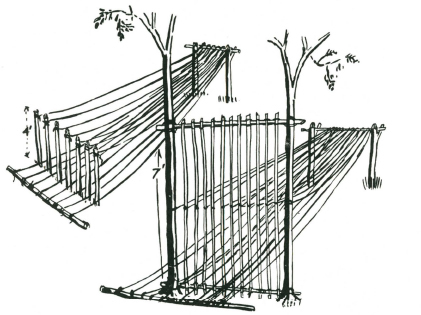
Eight or nine feet from the cross bar, and on the side farthest from the prongs, a row of straight, smooth stakes, each about four feet long, is driven into the ground so that there are about two inches between the centres of the stakes. These stakes should be trimmed of any side twigs or roughnesses. A weaving bar, a few inches longer than the width of the row of stakes, is cut and laid on the ground, parallel and about six inches in front of this row of stakes.
Your camp loom is now ready to be set up for weaving.
An alternative to the row of stakes, and a considerable improvement if a situation is available, is to select a site where two trees are at a convenient distance apart. At ground level, and about seven feet above the ground, two stout cross bars, two inches thick, are lashed to the tree trunks, and to these crossbars a series of smooth vertical sticks are lashed at top and bottom. These sticks are about two inches apart at centres.
TO WEAVE ON A CAMP LOOM
Lengths of the weaving material are tied to the stakes as shown, brought back over the cross bar, and then forward and between the stakes, and then tied to the weaving bar in front of the row of stakes. (This is the “weft” of your weaving.) A ball of material is tied to the outside strand, and then passed between the two rows of strands (this is the warp), with the weaving bar lying on the ground. The weaving bar is lifted above the weft, and the ball returned again between the weft threads. Repeat by alternately lifting and lowering the weaving bar.
CAMP MATTRESS OR STICK HAMMOCK
The weft or long strands are set up as for weaving, but instead of warp (cross strands), tufts of grass, fern or other material (or sticks if for a stick hammock) are passed between the weft. In weaving a camp mattress it is advisable to put in a warp tie every second or third lift. This binds the sides and prevents the outside weft strands spreading.